CONFUSION SURROUNDS USTR PORT FEES IMPLEMENTATION
Additional fees for Chinese owned/operated and China-built vessels calling at US ports come into force on 14 October but confusion reigns over implementation.
Marcus Hand, Editor

Credit: CMA CGM
“What is happening with USTR is as clear as mud,” was the comment of one speaker at the Marine Money Asia conference in Singapore this week.
In the nearly six months since the from the announcement on 14 April that the United States Trade Representative (USTR) on port fees related to its 301 investigation into China’s dominance of global shipbuilding scant few details have emerged on practical implementation.
The fees will be charged for Chinese owned and operated vessels will be $50 per net tonne (NT) from 14 October 2025 rising to $140 per NT in 2028. For Chinese-built vessels the fee from 14 October 2025 will be $18 per NT or $120 per container rising to $33 per NT or $250 per container in 2028. Fees are capped at five times per vessel, per year.
Speaking at the Marine Money Asia conference Andrew MacAllister, Partner at law firm Holland & Knight, said 19% of the global fleet was Chinese owned by Chinese entities.
The US Customs and Border Protection Agency has been designated as the collection agency for the fees.
McAllister noted an FAQ had been promised by the US authorities on the processes surrounding the fees but this was yet to be released.
Writing on LinkedIn Lars Jensen from Verspucci Maritime said there had been questions raised to USTR by the industry over practical implementation of the fees.
“In a note the USTR has responded to some of the bodies making the inquiries ‘[...] We are working to provide additional clarity to outstanding questions raised by stakeholders. We are aware of the upcoming October 14 fees and working diligently to release this information in advance’.”
One particular area of concern flagged at the conference in Singapore was the treatment of ships financed under Chinese leasing arrangements and the question of how vessel would be captured in relation to the finance lease. Christoforos Bisbikos, Partner & Head of Asia Finance, Watson Farley & Williams, said there was “no clarity” on this point.
Despite the lack of clear guidance on implementation of the fees some container lines have made announcements on their plans for calling the US. Earlier this week Maersk joined CMA CGM in saying there would be no surcharges for US shipments implemented on 14 October.
Non-Chinese lines have been adjusting vessel deployments to shift Chinese-built vessels to other trades that do not call the US.
Chinese-owned lines Cosco Shipping Container Lines and OOCL have said they were committed to serving their customers to and from US markets but were short on details.
Meanwhile Holland & Knight’s McAllister advised owners to conduct a complete analysis of vessel ownership and operator and build of vessel fleet. He also said that owners should clearly assign responsibilities for port fees in charter party or other legal documents.
Marcus Hand






